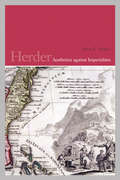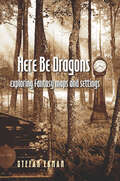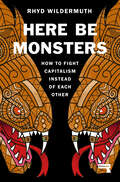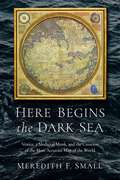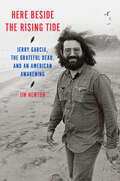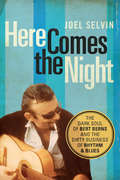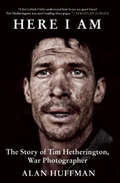- Table View
- List View
Herculine Barbin: Being the Recently Discovered Memoirs of a Nineteenth-Century French Hermaphrodite
by Michel Foucault Richard McdougallWith an eye for the sensual bloom of young schoolgirls, and the torrid style of the romantic novels of her day, Herculine Barbin tells the story of her life as a hermaphrodite. Herculine was designated female at birth. A pious girl in a Catholic orphanage, a bewildered adolescent enchanted by the ripening bodies of her classmates, a passionate lover of another schoolmistress, she is suddenly reclassified as a man. Alone and desolate, he commits suicide at the age of thirty in a miserable attic in Paris. Here, in an erotic diary, is one lost voice from our sexual past. Provocative, articulate, eerily prescient as she imagines her corpse under the probing instruments of scientists, Herculine brings a disturbing perspective to our own notions of sexuality. Michel Foucault, who discovered these memoirs in the archives of the French Department of Public Hygiene, presents them with the graphic medical descriptions of Herculine's body before and after her death. In a striking contrast, a painfully confused young person and the doctors who examine her try to sort out the nature of masculine and feminine at the dawn of the age of modern sexuality. "Herculine Barbin can be savored like a libertine novel. The ingenousness of Herculine, the passionate yet equivocal tenderness which thrusts her into the arms, even into the beds, of her companions, gives these pages a charm strangely erotic. . . Michel Foucault has a genius for bringing to light texts and reviving destinies outside the ordinary. " Le Monde, July 1978
Herder
by John K. NoyesAmong his generation of intellectuals, the eighteenth-century German philosopher Johann Gottfried Herder is recognized both for his innovative philosophy of language and history and for his passionate criticism of racism, colonialism, and imperialism. A student of Immanuel Kant, Herder challenged the idea that anyone - even the philosophers of the Enlightenment - could have a monopoly on truth.In Herder: Aesthetics against Imperialism, John K. Noyes plumbs the connections between Herder's anti-imperialism, often acknowledged but rarely explored in depth, and his epistemological investigations. Noyes argues that Herder's anti-rationalist epistemology, his rejection of universal conceptions of truth, knowledge, and justice, constitutes the first attempt to establish not just a moral but an epistemological foundation for anti-imperialism. Engaging with the work of postcolonial theorists such Dipesh Chakrabarty and Gayatri Spivak, this book is a valuable reassessment of Enlightenment anti-imperialism that demonstrates Herder's continuing relevance to postcolonial studies today.
Herder and Enlightenment Politics (Ideas in Context #147)
by Eva PiirimäeJohann Gottfried Herder initiated the modern disciplines of philosophical anthropology and cultural history, including the study of popular culture. He is also remembered as a sharp critic of colonialism and imperialism. But what types of social, economic and political arrangements did Herder envision for modern European societies? Herder and Enlightenment Politics provides a radically new interpretation of Herder's political thought, situating his ideas in Enlightenment debates on modern patriotism, commerce and peace. By reconstructing Herder's engagement with Rousseau, Montesquieu, Abbt, Ferguson, Möser, Kant and many other contemporary authors, Eva Piirimäe shows that Herder was deeply interested in the potential for cultural, moral and political reform in Russia, Germany and Europe. Herder probed the foundations of modern liberty, community and peace, developing a distinctive understanding of human self-determination, natural sociability and modern patriotism as well as advocating a vision of Europe as a commercially and culturally interconnected community of peoples.
Herder's Naturalist Aesthetics
by Rachel ZuckertIn this book, Rachel Zuckert provides the first overarching account of Johann Gottfried Herder's complex aesthetic theory. She guides the reader through Herder's texts, showing how they relate to eighteenth- and nineteenth-century European philosophy of art, and focusing on two main concepts: aesthetic naturalism, the view that art is natural to and naturally valuable for human beings as organic, embodied beings, and - unusually for Herder's time - aesthetic pluralism, the view that aesthetic value takes many diverse and culturally varying forms. Zuckert argues that Herder's theory plays a pivotal role in the history of philosophical aesthetics, marking the transition from the eighteenth-century focus on aesthetic value as grounded in human nature to the nineteenth-century focus on art as socially significant and historically variable. Her study illuminates Herder's significance as an innovative thinker in aesthetics, and will interest a range of readers in philosophy of art and European thought.
Herder's Political Thought
by Vicki A. SpencerJohann Gottfried Herder was a philosopher and important intellectual presence in eighteenth-century Germany. Herder's Political Thought examines the work of this significant figure in the context of both historical and contemporary developments in political philosophy.Vicki A. Spencer reveals Herder as one of the first Western philosophers to grapple seriously with cultural diversity without abandoning a commitment to universal values and the first to make language and culture an issue of justice. As Spencer argues, both have made Herder a source of inspiration for the pluralist turn of contemporary political philosophy. Contending that in an era of globalization, it is no longer possible to ignore Herder's crucial insights on the relationship between cultural membership and individual identity, Spencer demonstrates how these ideas can help us understand, and perhaps resolve, the linguistic and cultural-political struggles of our times.
Herder: Philosophical Writings
by Michael N. Forster Johann Gottfried Herder Karl Ameriks Desmond M. ClarkeHerder is a figure of considerable importance in the history of philosophy and the history of ideas. His far-reaching influence encompasses philosophy--Hegel, Schleiermacher, Nietzsche, literature--Goethe, Schiller and linguistics--von Humboldt. This volume presents a comprehensive selection of his writings in a new translation, with an introduction that sets them in their philosophical and historical context.
Here Be Dragons
by Sharon Kay PenmanIn the thirteenth century, the Prince of North Wales marries English King John's daughter, Joanna. But the conflict between England and Wales continues. Now, Joanna must decide which man to follow - her father or her husband.
Here Be Dragons: Exploring Fantasy Maps and Settings
by Stefan Ekman Stefar EkmanFirst in-depth study of the use of landscape in fantasy literatureWinner of the Mythopoeic Scholarship Award for Myth and Fantasy Studies (2016) Fantasy worlds are never mere backdrops. They are an integral part of the work, and refuse to remain separate from other elements. These worlds combine landscape with narrative logic by incorporating alternative rules about cause and effect or physical transformation. They become actors in the drama—interacting with the characters, offering assistance or hindrance, and making ethical demands. In Here Be Dragons, Stefan Ekman provides a wide-ranging survey of the ubiquitous fantasy map as the point of departure for an in-depth discussion of what such maps can tell us about what is important in the fictional worlds and the stories that take place there. With particular focus on J. R. R. Tolkien's The Lord of the Rings, Ekman shows how fantasy settings deserve serious attention from both readers and critics. Includes insightful readings of works by Steven Brust, Garth Nix, Robert Holdstock, Terry Pratchett, Charles de Lint, China Miéville, Patricia McKillip, Tim Powers, Lisa Goldstein, Steven R. Donaldson, Robert Jordan, and Neil Gaiman and Charles Vess.
Here Be Monsters: How to Fight Capitalism Instead of Each Other
by Rhyd WildermuthA clear and engaging history of how left radicalism went wrong and how it can become what it must be again.Here Be Monsters speaks to a left that has forgotten its history, its potential, and its power.Gramsci spoke of a time of monsters or morbid symptoms. In the ancient world, monsters were not enemies, but rather divine warnings, symptoms of a world out of balance. Here Be Monsters meets these monsters and listens to what they have to tell us.Interweaving personal stories with engaging histories of political thought and the meanings of monsters, Rhyd Wildermuth reveals the roots of current identity conflicts and political contradictions in feminism, anti-racist theory, Marxism, Frankfurt School theorists, and the many other leftist attempts to put the world back into balance.The left has always been the province of dreamers and visionaries, or as Ursula K. Le Guin named them, &“realists of a larger reality.&” Here Be Monsters is an urgent and deeply engaging narrative to help us remember that reality once more.
Here Begins the Dark Sea: Venice, a Medieval Monk, and the Creation of the Most Accurate Map of the World
by Meredith Francesca SmallThe remarkable story of the cartographic masterpiece—the Venetian mappa mundi—that revolutionized how we see the world.In 1459 a Venetian monk named Fra Mauro completed an astonishing map of the world. Seven feet in diameter, Fra Mauro&’s mappamundi is the oldest and most complete Medieval map to survive into modernity. And in its time, this groundbreaking mappamundi provided the most detailed description of the known world, incorporating accurate observation, and geographic reality, urging viewers to see water and land as they really existed. Fra Mauro's map was the first in history to show that a ship could circumnavigate Africa, and that the Indian &“Sea&” was in fact an ocean, enabling international trade to expand across the globe. Acclaimed anthropologist Meredith F. Small reveals how Fra Mauro&’s mappamundi made cartography into a science rather than a practice based on religion and ancient myths. Here Begins the Dark Sea brings Fra Mauro&’s masterpiece to life as a work of art and a window into Venetian society and culture. In telling the story of this cornerstone of modern cartography, Small takes the reader on a fascinating journey as she explores the human urge to find our way. Here Begins the Dark Sea is a riveting testament to the undeniable impact Fra Mauro and his mappamundi have had over the past five centuries and still holds relevance today.
Here Beside the Rising Tide: Jerry Garcia, the Grateful Dead, and an American Awakening
by Jim NewtonA kaleidoscopic history of the Grateful Dead that explores the American counterculture through the life of iconoclastic frontman Jerry Garcia, and his merry band&“By writing this book, Jim Newton informs the rest of the world what Deadheads have known for years: that Jerry Garcia was more than a world-class musician, he was an American icon.&”—Trixie GarciaIn 1965, in Palo Alto, Jerry Garcia opened a dictionary to a fable in which an appreciative soul repays the generosity of a traveler, a &“gift of the grateful dead.&” After a traumatic car accident that injured him and killed a close friend, Garcia had resolved to build his life around music. He had practiced relentlessly and caromed across the northern California folk and bluegrass scene. He had gathered up some fellow musicians and formed a band.Now they had their name.Following the history of the Grateful Dead means tracking American cultural history through a period of radical reconsideration. The Dead played at the Acid Tests and the Human Be-In and Woodstock, at the occupation of Columbia and the Bail Ball for People&’s Park. They performed at the base of the Pyramids during a lunar eclipse, at Madison Square Garden to defend the rainforests, in San Francisco to sound the alarm over AIDS and at Huey Newton&’s birthday party. For three decades, the band explored the meaning and limits of freedom.The radical message of the Dead, to reject the mainstream and build a bohemian community, radiated across the world, manifesting itself in art, music, business, and politics. Here Beside the Rising Tide tells the story of those disparate shafts of light, putting Garcia into a broader context while tracing his eventful life.Nearly a century after his birth, Garcia&’s influence stretches onward, expressed in guitar licks and a gentle way of life, one of excellence and gratitude, chasing freedom, living moment to moment, guided by song—the gift of the Grateful Dead.
Here Burns My Candle: A Novel (Here Burns My Candle Series #1)
by Liz Curtis HiggsA mother who cannot face her future. A daughter who cannot escape her past. Lady Elisabeth Kerr is a keeper of secrets. A Highlander by birth and a Lowlander by marriage, she honors theauldways, even as doubts and fears stir deep within her. Her husband, Lord Donald, has secrets of his own, well hidden from the household, yet whispered among the town gossips. His mother, the dowager Lady Marjory, hides gold beneath her floor and guilt inside her heart. Though her two abiding passions are maintain...
Here Come the Girl Scouts!: The Amazing All-true Story of Juliette "Daisy" Gordon Low and Her Great Adventure
by Shana CoreyThe amazing, all-true story of the first Girl Scouts and their visionary founder.Juliette Gordon Low--Daisy to her friends and family--was not like most girls of the Victorian era. Prim and proper? BOSH! Dainty and delicate? HOW BORING! She loved the outdoors, and she yearned for adventure! Born into a family of pathfinders and pioneers, she too wanted to make a difference in the world--and nothing would stop her. Combining her ancestors' passion for service with her own adventurous spirit and her belief that girls could do anything, she founded the Girl Scouts. One hundred years later, they continue to have adventures, do good deeds, and make a difference!
Here Come the Marines!: The Story of the Devil Dogs, from Tripoli to Wake Island
by Alexander R. GriffinAfter the bitter fighting against the U.S. Marines in Belleau Wood during WWI, the German commanders on the spot wrote to their high command that they were fighting “Teufel Hunde” or Devil Dogs. The ferocious nickname stuck to the U.S. Marine Corps, who referred to themselves as Devil Dogs to this day.In this gripping account, written soon after the U.S. entry to WWII and the heroic defence of Wake Island came to a close, veteran writer Alexander Griffin recounts the famous history of the Marine Corps. From the shores of Tripoli, through the Halls of Montezuma to the hellish conditions of the Pacific the grit, determination and fighting spirit of the U.S. Marines shines through.
Here Comes Harry
by Hilda LewisOUR STORY OPENS with the birth of the child that, in less than a year, is to be King of England--Henry VI. His father, Henry of Agincourt, fighting for the crown of France, won great victories. He married Catherine, daughter of the French King; and, by treaty as well as by conquest, was declared heir to the throne of France. He dies young and his son is proclaimed King of England and of France. But, 'French hearts don't turn English at the stroke of a pen', and the war goes on--until France is lost. Our story deals with two boys, each called Harry. One is Henry VI, Harry of Lancaster, who gives his name to the book. The other is Harry Rushden, a goldsmith's apprentice who is brought into friendship with the King. All that happens in the story is seen through his eyes.
Here Comes Trouble: Shortlisted for the Bollinger Everyman Wodehouse Prize for Comic Fiction
by Simon WroeFollowing his expulsion from school, seventeen-year-old dreamer Ellis Dau is sent to work with his father. His father is editor of The Chronicle, the last bastion of free speech in their strange, strange land. And it is under threat: from heavy-handed policemen, mysterious revolutionaries, and the resident Russian billionaire. As Ellis navigates his collapsing, blacked-out city - and his feelings for the oligarch's beautiful daughter - he realises that some things are worth fighting for. But can he save his family and the newspaper fuelled only by youth, grain spirit and unrequited love?Read by Max Dowler(p) 2017 Orion Publishing Group
Here Comes the Bride
by Pamela MorsiFrom a RITA Award winning author, “endearing characters . . . Texas small-town ambiance . . . this heartwarming romance provides a generous slice of Americana” (Library Journal).There comes a time in every woman's life when she must get herself a man or give up the idea entirely . . . After three long years of patiently waiting for her reluctant, handsome, gentlemanly Amos Dewey, to pop the question, Augusta Mudd—owner of her small town's biggest factory—decides it's time to take matters in her own hands. With the help of her friend, ruggedly attractive Rome Akers, she's determined to make Amos jealous—and get him to the altar—before it's too late.Rome Akers wasn't ready to settle down. But by pretending to make Augusta his partner for life he had a chance to become her business partner instead. Yet despite his best intentions, the closer he gets to this intelligent, sweet woman, the stronger his feelings grow. Their tantalizing conversations and tender kisses ignite a desire more passionate than Roman ever imagined. Soon he'll do anything to make Augusta a bride—but only if he gets to be the groom.Praise for Pamela Morsi: ”The Garrison Keillor of romance.” —Publishers Weekly“An author with a deft perception of human nature.” —Indianapolis Star
Here Comes the Bride (bundle set): A Bride For Lord Brasleigh, A Bride For Lord Wickton, A Bride For Lord Challmond
by Alexandra IvyDear Reader,Long before I wrote my sexy paranormal romances, I wrote traditional Regency romances as Debbie Raleigh. Now I’m delighted that three of my favorites are available once more. This trilogy features three dashing rakes returning home from war. But along the way, a gypsy predicts that love will trap them all. Their high-spirited response? A daring wager! By June the first, whomever Cupid catches must forfeit one thousand pounds and a red rose . . .A BRIDE FOR LORD BRASLEIGHPhilip Marrow, Lord Brasleigh, must marry off his troublesome ward, Miss Bella Howe. But determined to wed for love, Bella has run away, and Philip must track her down. Since he has never met her, he plans to play the rogue and scare her back to London. He never expects to ignite an overwhelming passion . . . or find a lady who fights fire with a clever scheme all her own . . .A BRIDE FOR LORD WICKTONBarth Juston, Earl of Wickton, assumes a woman would be grateful to accept an arranged marriage with him. What a shock that beautiful Isa Lawford is not! In fact, she insists she prefers someone else! Now this overconfident lord is about to enter the most perilous battle of all: a fight for a woman’s heart . . .A BRIDE FOR LORD CHALLMONDSimon Townsled, Lord Challmond, is off to his Devonshire country estate, where he is sure to be safe from feminine wiles. But he doesn't count on feisty do-gooder Miss Claire Blakewell—who is as determined to march down the aisle as he is to avoid it . . .I’ve fallen head over heels for these timeless books all over again, and believe that you will too.Alexandra Ivy
Here Comes the Night: The Dark Soul of Bert Berns and the Dirty Business of Rhythm and Blues
by Joel Selvin"I don't know where he's buried, but if I did I'd piss on his grave." -Jerry Wexler, best friend and mentorHere Comes the Night: Bert Berns and the Dirty Business of Rhythm and Blues is both a definitive account of the New York rhythm and blues world of the early '60s, and the harrowing, ultimately tragic story of songwriter and record producer Bert Berns, whose meteoric career was fueled by his pending doom. His heart damaged by rheumatic fever as a youth, doctors told Berns he would not live to see twenty-one. Although his name is little remembered today, Berns worked alongside all the greats of the era - Jerry Leiber and Mike Stoller, Ahmet Ertegun and Jerry Wexler, Burt Bacharach, Phil Spector, Gerry Goffin and Carole King, anyone who was anyone in New York rhythm and blues. In seven quick years, he went from nobody to the top of the pops - producer of monumental r&b classics, songwriter of "Twist and Shout," "My Girl Sloopy" and others.His fury to succeed led Berns to use his Mafia associations to muscle Atlantic Records out of a partnership and intimidate new talents like Neil Diamond and Van Morrison he signed to his record label, only to drop dead of a long expected fatal heart attack, just when he was seeing his grandest plans and life's ambitions frustrated and foiled.
Here Down on Dark Earth: Loss and Remembrance in New York City
by Larry RacioppoDiscover New York’s poignant memorials through powerful photographs capturing everything from fleeting tributes to enduring monumentsThe photographs in Here Down on Dark Earth document the many ways New Yorkers express their intertwined feelings of loss and remembrance. The famous and the unknown, the rich and the poor, meet the same fate, but how they are mourned and remembered varies greatly. New York City’s monuments and memorials are large and small, civic and personal, traditional and vernacular, planned and spontaneous. Some commemorate a significant event such as the terrorist attack on the World Trade Center, others the death of a single child hit by a stray bullet. A memorial of stone and steel dedicated to deceased WWII veterans from a church parish may outlast a painted Rest-In-Peace (RIP) memorial wall for a slain teenager. Still, both grow out of the feeling of loss and a desire to preserve the memory of departed loved ones.As Racioppo traveled throughout New York City, he became increasingly aware of the impermanence of these memorials. The paint eventually peels, and the image gradually disappears. Sanitation workers remove the rotted toys and flowers. Small and personal, or large and communal, created by professionals or amateurs, the memorials in Here Down on Dark Earth express a powerful sense of loss and connection. Throughout the book, the author’s contextual notes accompany the poignant photographs depicting these expressions of remembrance.
Here First: Autobiographical Essays by Native American Writers
by Brian Swann Arnold Krupat<i>Here First</i> is an important new collection of essays by Native American writers compiled by Arnold Krupat and Brian Swann, the editors of <i>I Tell You Now: Autobiographical Essays by Native American Writers</i>. In <i>Here First</i>, authors such as Sherman Alexie, Greg Sarris, and Elizabeth Woody tell the stories of their lives and their art. Each essay demonstrates the breadth of experience of twenty-seven individuals united in the creative expression of a Native American heritage. Each has a different relation to that heritage, and in describing it through personal and family history, with verse and in anecdotes, the writers give a strong image of the different cultures that have shaped them. This is living history and the kind of collective memoir that makes for fascinating and rewarding reading--one of the most vivid and diverse portraits of Native American culture available today.
Here First: Samoset and the Wawenock of Pemaquid, Maine
by Jody BachelderOn March 16, 1621, Samoset, a sagamore of the Wawenock, cemented his place in history. He was the first Indigenous person to make contact with the colonists at Plymouth Plantation, startling them when he emerged from the forest and welcomed them in English. The extraordinary thing about Samoset&’s story is that he was not from Plymouth. He was not even Wampanoag, or Patuxet, who lived in the area. Samoset&’s home was more than 200 miles away on the coast of present-day Maine. Why was he there? And why was he chosen to make contact with the English settlers?In addition to that first meeting in Plymouth, Samoset&’s life coincided with several important events during the period of early contact with Europeans, and his home village of Pemaquid lay at the center of Indigenous-European interactions at the beginning of the 17th century. As a result he and his people, the Wawenock, were active participants in this history. But it came at great cost, and the way of living that had sustained them for centuries changed dramatically over the course of his lifetime as they endured war, epidemics, and a clash of cultures. This is their story.
Here I Am: The Story of Tim Hetherington, War Photographer
by Alan Huffman“Not only does Huffman bring Tim back to life . . . but he also leads us through some of the most harrowing combat of our generation” (Sebastian Junger, New York Times–bestselling author of Tribe). Tim Hetherington (1970–2011) was one of the world’s most distinguished and dedicated photojournalists, whose career was tragically cut short when he died in a mortar blast while covering the Libyan Civil War. Someone far less interested in professional glory than revealing to the world the realities of people living in extremely difficult circumstances, Hetherington nonetheless won many awards for his war reporting, and was nominated for an Academy Award for his critically acclaimed documentary, Restrepo. In Here I Am, Alan Huffman tells Hetherington’s life story, and through it analyses, what it means to be a war reporter in the twenty-first century. Huffman recounts the camerman’s life from his first interest in photography and war reporting, through his critical role in reporting the Liberian Civil War, to his tragic death in Libya. Huffman also traces Hetherington’s photographic milestones, from his iconic and prize-winning pictures of Liberian children, to the celebrated portraits of sleeping US soldiers in Afghanistan. “A powerfully written biography . . . This is poignant imagery and metaphor for the entire body of this extraordinary artist and humanist’s life.” —The Huffington Post “Huffman excels at heightening the drama, depicting the rapid-fire action and constant danger of working among soldiers and guerrillas engaged in battle.” —The Boston Globe “Huffman vividly chronicles the short life of a man drawn to danger zones to capture the horrors of modern warfare.” —Los Angeles Times “Celebrate[s] Tim Hetherington’s life . . . Recount[s] his last days in Libya in excruciating detail.” —Time
Here Is Where: Discovering America's Great Forgotten History
by Andrew CarrollHere Is Where chronicles Andrew Carroll's eye-opening - and at times hilarious -- journey across America to find and explore unmarked historic sites where extraordinary moments occurred and remarkable individuals once lived. Sparking the idea for this book was Carroll's visit to the spot where Abraham Lincoln's son was saved by the brother of Lincoln's assassin. Carroll wondered, How many other unmarked places are there where intriguing events have unfolded and that we walk past every day, not realizing their significance? To answer that question, Carroll ultimately trekked to every region of the country -- by car, train, plane, helicopter, bus, bike, and kayak and on foot. Among the things he learned: *Where in North America the oldest sample of human DNA was discovered * Where America's deadliest maritime disaster took place, a calamity worse than the fate of the Titanic *Which virtually unknown American scientist saved hundreds of millions of lives *Which famous Prohibition agent was the brother of a notorious gangster *How a 14-year-old farm boy's brainstorm led to the creation of television Featured prominently in Here Is Where are an abundance of firsts (from the first use of modern anesthesia to the first cremation to the first murder conviction based on forensic evidence); outrages (from riots to massacres to forced sterilizations); and breakthroughs (from the invention, inside a prison, of a revolutionary weapon; to the recovery, deep in the Alaskan tundra, of a super-virus; to the building of the rocket that made possible space travel). Here Is Where is thoroughly entertaining, but it's also a profound reminder that the places we pass by often harbor amazing secrets and that there are countless other astonishing stories still out there, waiting to be found. ition.
Here Is Your War [Illustrated Edition]
by Ernie PyleIncludes over 150 images recording the career of Ernie Pyle from childhood to Ie Shima.Out of the foxholes he shared with them, and from his own heart straight to the folks back home, comes Ernie Pyle’s story of our soldiers’ first big campaign abroad. He takes you to live with them on the great adventure of their lives, and tells you the thousands of little things you want to know about how they are living this war from day to day. To Ernie Pyle they are the same boys we have always known, from the Main Streets, Broadways and farms throughout America. They are the boys who had to learn much of the art of war as they went along, who often paid a bitter price for their knowledge. They emerge by the hundreds from these pages as the living, gallant, unpretentiously heroic Americans who are writing one of the great chapters of our history.For six months Ernie Pyle...wrote news columns about the war in Tunisia which were increasingly recognized as one of the greatest pieces of reporting in American journalism. Toward the end of the campaign they were running on the front pages of countless newspapers. Americans discovered in them a new feeling about the war, a human warmth, an unstereotyped approach—in other words, exactly what they were most interested in—not grand strategy but how the boys were making out. These columns, in full-length form in which they were individually filed, form the basis for a wonderfully moving story of our soldiers throughout the entire campaign, from embarkation from England through ultimate victory. HERE IS YOUR WAR is great reporting indeed, but more than that it is a book of timeless and permanent excellence.“A full-length, deeply human portrait of the American soldier in action...the things that those at home want most to know.”—EDWARD STREETER, N.Y. Times Book Review

